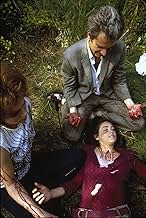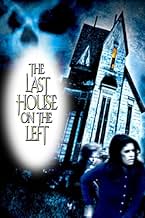Due ragazze adolescenti che si recano a un concerto rock per il proprio compleanno cercano di spartire marijuana in città, dove vengono rapite e brutalizzate da una banda di detenuti psicoti... Leggi tuttoDue ragazze adolescenti che si recano a un concerto rock per il proprio compleanno cercano di spartire marijuana in città, dove vengono rapite e brutalizzate da una banda di detenuti psicotici.Due ragazze adolescenti che si recano a un concerto rock per il proprio compleanno cercano di spartire marijuana in città, dove vengono rapite e brutalizzate da una banda di detenuti psicotici.
- Premi
- 1 candidatura in totale
- Mari Collingwood
- (as Sandra Cassell)
- Krug Stillo
- (as David A. Hess)
- Fred 'Weasel' Podowski
- (as Fred Lincoln)
- Dr. John Collingwood
- (as Gaylord St. James)
- Boy with Balloon
- (non citato nei titoli originali)
- Ice Cream Store Clerk
- (non citato nei titoli originali)
- Hippie Taunting Deputy
- (non citato nei titoli originali)
Recensioni in evidenza
*** (out of 4)
Craven's notorious shocker is a remake of Ingmar Bergman's The Virgin Spring and deals with two teenage girls going to the city for a concert but being kidnapped by four crazed criminals. The girls and raped, tortured and eventually murdered but the killer's end up spending the night at one of the girl's houses where the tables are turned. I've seen this film countless times in my life and it always disturbed me to the point where I hated the movie with a passion. I always felt the movie was rather poorly made and in the end it was nothing but an exploitation show meant to disturb you. I still feel that way but I've actually doubled my normal star rating because the film actually worked with me this time. My stomach was still being turned and I was disgusted in its vile nature but I reckon that was the whole point. There's still a lot that I don't like about the film including the stupid comedy relief from the two idiot cops. Why Craven decided to throw this slapstick in is beyond me because it really feels out of place especially when it pops up after watching two teens get brutally murdered. Another issue is that the film looks incredibly cheap (it was a low budget) and amateurish but this adds some to its atmosphere and makes the film seem all the more real. The now legendary tagline that "it's only a movie" is something to really keep in mind as the film comes off very realistic as if you're watching a documentary. The performances are all rather mixed but they all suit the film fine and that includes David Hess as the leader of the gang and Marc Sheffler as his heroin addicted son. The dialogue in the film, especially the opening ten minutes, is downright awful but there's still no denying that this is a highly disturbing film that manages to be vile, disgusting and just downright evil.
The story, although claimed as true, is an adaptation of Ingmar Bergman's Jungfrukällan (aka The Virgin Spring, 1960). Roughly, it is the story of Mari Collingwood (Sandra Cassel). We see Mari at home with her almost-hip parents. Mari is about to head out to a "Bloodlust" concert in New York City with her new friend Phyllis Stone (Lucy Grantham). Mom and dad are harassing her about her clothing, which is thin enough to show off a bit of flesh, but they're not so un-hip as to make her change. Meanwhile, we learn from a radio that four convicts--"murderers, dope-pushers and rapists"--have just escaped from prison. At the same time, director Wes Craven slowly reveals the quartet--Krug Stillo (David A. Hess), Junior Stillo (Marc Sheffler), Fred "Weasel" Podowski (Fred J. Lincoln) and Sadie (Jeramie Rain). They're holed up in a New York City apartment. Sadie seems to be group property, and that causes some tension. It is suggested that they look for a couple more women. Mari and Phyllis end up at the wrong place at the wrong time. They're kidnapped, and mayhem ensues. But there's a twist that arrives when the convict's car breaks down in an ironic location.
"Frightening", "disturbing", "sick" and various other terms are frequently employed when describing Last House on the Left. Since I find no films scary, I can't vouch for the first term, but the other two would perhaps apply proportionate to how many horror films you regularly watch, and just what kinds of horror films. If you're not used to the genre in its grittier and gorier post-1960s instantiations, you'd likely find The Last House on the Left shocking. If you've seen a large number of films such as The Texas Chainsaw Massacre (1974), Cannibal Holocaust (1980), Henry: Portrait of a Serial Killer (1986) and so on, don't pay too much attention to the hype. You're not likely to be very disturbed by anything you see here.
That doesn't mean that you'll not enjoy this film. After all, it has been a major influence on the films mentioned above--there is even an important chainsaw scene here. That's especially remarkable when we consider that it was only Craven and Producer Sean S. Cunningham's second film. They had been approached by a consortium of exhibitors who said that they wanted "something as appalling and exploitable as Night of the Living Dead (1968)".
Maybe largely by accident, Craven and Cunningham (along with others, such as assistant producer Steve Miner, who later became much bigger "names" in horror--between these three, we have the helmers of a number of films in the three major 1980s/1990s franchises--Halloween, Friday the 13th and A Nightmare on Elm Street) happened upon an unusual cinema vérité style that made the horrific situations depicted seem much more immediate and real. Combined with occasionally graphic and always intense situations of violence and control, the final effect is akin to watching a home video/snuff film. In fact, it was promoted as such in some areas, and the effect was disturbing enough in its time that the film initially received an X rating and was banned for many years in some locales.
But again, focusing on that amounts to hype now, and shouldn't be taken too seriously, lest it lead to inflated expectations. Just as surprising on a first viewing is that The Last House on the Left has an intermittent goofy sense of humor and a "groovy" attitude that is firmly mired in the early 1970s. The two policemen are really comic relief characters (and very funny at that), but there is also a lot of humor surrounding the criminal quartet--this almost becomes a "black comedy" at times. These sensibilities even extend to the music, which has a frequent hillbilly edge and lyrics that supply ex-positional material. Surprisingly, Hess, who plays Krug, wrote the music.
Despite the simplicity of the story and the fact that the 2002 MGM DVD release is the "most complete cut ever" according to Craven, there are problems with the story, whether due to the script or the editing. Too many segues between major plot points are "jumpy". The chase(s) through the woods seems a bit random. It's not very well explained how the convicts end up at a home looking as they do. Two characters find another who was missing, and it seems more like a dream sequence because of its arbitrariness, and so on.
But overall, the story is effective enough. Although many subtexts can and have been read into the film, the most interesting theme to me was that it's largely a "tragedy of happenstance". Craven seems to be expressing a strong belief in chance and coincidence and focusing on the dark side of it. Under that reading, we can maybe excuse some of the narrative jumps more easily.
Although there are a number of similar films that I think are better than The Last House on the Left, including Ruggero Deodato's House at the Edge of the Park (aka La Casa sperduta nel parco, 1980)--also starring Hess in a similar role, curiously enough, this is a must-see for serious horror fans because of its historical importance.
However, the film manages to maintain an intense atmosphere in its more serious moments, whether through Craven's direction or the image quality that gives it an amateur feel, as if we were witnessing real events on camera. The film's plot may not be particularly innovative, but it makes up for it with its scenes of violence, which at the time were, in a way, considered a novelty.
Although it has aged somewhat problematically in certain respects, "The Last House on the Left" still retains its disturbing power and deserves to be appreciated, especially for its lasting influence on the genre, serving as inspiration for countless other films.
Wes Craven and Sean Cunnigham (who worked together on this and then went ahead to make two of the most iconic horror/movie villains of all time respectively - Freddy Kruger and Jason Vorhees) may feel like they wanted more or rather be more diverse. Do movies in other genres - but I do think they can be happy with their career. And it started with a very controversial and evil little movie like this one.
The villains here are as despicable as they can get and the one moment where Wes claims they have a point of no return - well let's just say they are already past that way before that moment. So this is raw, it lacks sense in many respects and you can see there was not a big budget involved. But through it all you can feel the effect until today the movie had ... because of its success and because it was rough and did not really follow any rules
Lo sapevi?
- QuizA mixture of red and blue food colouring mixed with caramel syrup was used for the fake blood, which contrary to most film "blood," actually looks real.
- BlooperMari breathes and moves when her parents find her body (the original intention was that she should still be alive at this point and would identify her attackers before dying).
- Citazioni
Estelle Collingwood: Mari tells me you're from Manhattan. What does your father do?
Phyllis Stone: Oh, my parents are in the iron and steal business.
Estelle Collingwood: Iron and steel both together? How unusual.
Phyllis Stone: Well, my mother irons and my father steals.
- Curiosità sui creditiOpening text: "The events you are about to witness are true. Names and locations have been changed to protect those individuals still living."
- Versioni alternativeThe 1982 British release on the Replay video label omitted the scene where the sheriff and the deputy try to hitch a ride on Ada's chicken wagon, and the end credits were missing - though the now familiar 'freeze frames' of the principal actors appear, no credits are superimposed over them, and the final song continues to play over a completely black screen. In terms of gore and violence, the print Replay used was uncut.
- ConnessioniEdited into Civiltà del vizio (1977)
I più visti
Dettagli
- Data di uscita
- Paese di origine
- Sito ufficiale
- Lingua
- Celebre anche come
- La última casa a la izquierda
- Luoghi delle riprese
- New York, New York, Stati Uniti(buying grass scene)
- Aziende produttrici
- Vedi altri crediti dell’azienda su IMDbPro
Botteghino
- Budget
- 90.000 USD (previsto)
- Lordo in tutto il mondo
- 135 USD
Contribuisci a questa pagina

































